Roadstar Caravans has long been interested in fibreglass sandwich panel caravans. To Roadstar owner Ken Nizam, this construction methods was one of the final pieces of the puzzle. His vision for his company has long been the ability to offer customers any style of van they wanted, from caravans with meranti timber frames to one-piece fibreglass construction. If you’ve ever met Ken, you’d know that whatever Roadstar did, it would have to be at the highest possible standard.
When Roadstar launched the GT Sport Mk2 late in 2016, it heralded a new era for this company. With one-piece fibreglass walls and a one-piece front, roof and rear section, seamless joinery and healthy dose of clever thinking, the GT Sport Mk2 brought Roadstar a step closer to the fulfilment of Ken’s vision.
The Roadstar Little Rippa, a light semi-offroader, was the next van in the range to get the fibreglass treatment. Previously only built with a wooden frame and aluminium cladding, it is now available in the same one-piece fibreglass construction as the GT Sport Mk2. So what, you might ask, are the benefits?
GOING ’GLASS
Firstly, the sandwich panel walls and roof utilise an ‘extrusion’ foam core rather than the ‘expansion’ foam commonly used in the caravan industry. Extrusion foam, Roadstar says, is more thermally efficient than the alternative, and it doesn’t hold moisture. It’s also light and strong. Roadstar’s fibreglass panels, we know from experience, will happily take a beating.
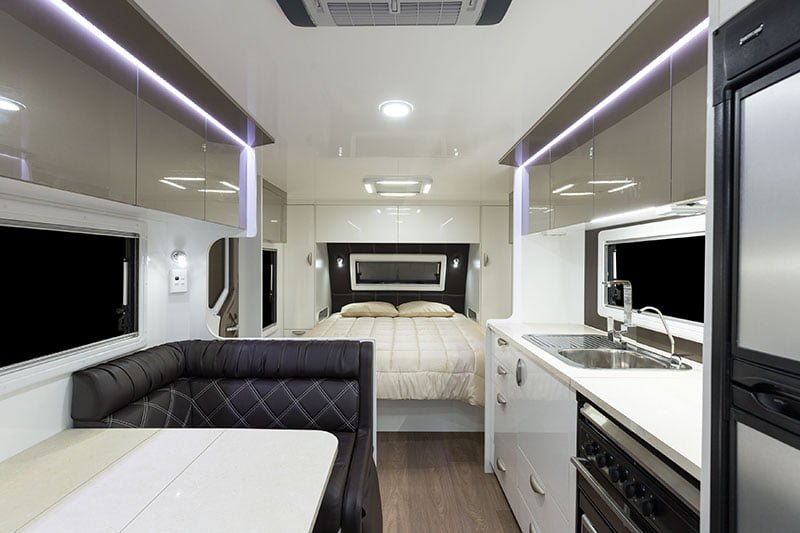 In fibreglass form, the Little Rippa looks every inch the serious, long-lasting caravan, the kind of rig that’ll be in the family for decades. As Ken says, these fibreglass vans take weeks to build, rather than the seven (or less) days required for a ‘stick and tin’ caravan. For example, production on a van will stop for long periods while the crew waits for the bonding agents on certain components, such as external checkerplate, to cure.
In fibreglass form, the Little Rippa looks every inch the serious, long-lasting caravan, the kind of rig that’ll be in the family for decades. As Ken says, these fibreglass vans take weeks to build, rather than the seven (or less) days required for a ‘stick and tin’ caravan. For example, production on a van will stop for long periods while the crew waits for the bonding agents on certain components, such as external checkerplate, to cure.
The nature of fibreglass sandwich panel construction means, however, that layout changes or ‘tweaks’ here and there can’t be easily accommodated. A caravan with a traditional frame skinned with outer aluminium and inner ply gives its manufacturer much more freedom to, for example, move cabinets or re-route wiring. But fibreglass panels don’t have hollow wall spaces or wall studs to anchor cabinets to – the location of each cable, screw and reinforcement is carefully plotted and factored into the overall manufacturing process.
All joins in the fibreglass Little Rippa are precisely gapped with Novatio, a special sealant exclusive to Roadstar that cures almost instantly.
The van sports a waist of checkerplate, nearside fold-down picnic table, a couple of speakers, a fold-out step, and a Dometic roll-out awning. At the back of the van, you’ll find a rear-view camera. The fact is, with fibreglass panels, anything that will require wires, cameras included, should be installed (or pre-wired) when the van is built. It isn’t always practical to retrofit such items on fibreglass vans.
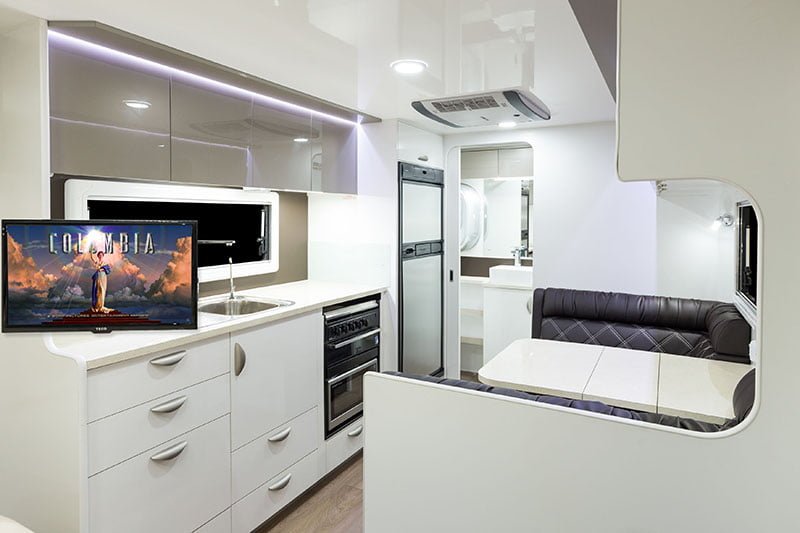 Up front, there’s a gal-lined tunnel boot (with 12V light), and a well-constructed checkerplate storage box featuring strong catches sits on the A-frame. This storage box is split into two sections, one housing the dual gas cylinders, the other housing a slide for a generator. Of course, this space could also be used for a portable fridge or simply as general storage. I liked the fact the gas cylinders are well and truly protected.
Up front, there’s a gal-lined tunnel boot (with 12V light), and a well-constructed checkerplate storage box featuring strong catches sits on the A-frame. This storage box is split into two sections, one housing the dual gas cylinders, the other housing a slide for a generator. Of course, this space could also be used for a portable fridge or simply as general storage. I liked the fact the gas cylinders are well and truly protected.
The A-frame-mounted tap, meanwhile, is mounted behind the storage box and a stoneguard, well and truly out of harm’s way.
The underside of the van is presented neatly. The 16in alloy wheels ride on Al-Ko Enduro Outback suspension, an offroad independent coil system that runs two shock absorbers per wheel. During our test tow, on various corrugated roads and undulating terrain, it performed to a high standard.
Two 95L fresh water tanks, each protected by a sheet of galvanised steel, are fitted beneath the Little Rippa, fore and aft of the suspension. It’s a decent amount of water storage, enough to keep you and your partner off the grid for five or six days – or more if you’re particularly water-wise.
It’s a single-axle van, so you’d be forgiven for thinking the Little Rippa offered only 300-400kg of load-carrying capacity. But how does 500kg sound? With about 200kg taken up by water and gas, the remaining 300kg is more than enough, even if you were to pack a 2kVA generator.
On the outside, this caravan is of a high standard. The fibreglass sandwich panels are smooth and free of imperfections, as though Roadstar has been working with this material for years. I struggled to find anything to fault.
INNER LITTLE RIPPA
Inside, the Little Rippa is appealing. The layout, with a front north-south bed, nearside dinette, offside kitchen, and rear ensuite, works well. The ensuite, featuring a wall-mounted washing machine (Ken is quick to point out that special bracing embedded in the wall panel is required to support the front-loader), cassette toilet, vanity and separate fibreglass shower, doesn’t substantially encroach on the living space; in fact, Roadstar has struck a reasonable balance between ensuite size and the amount of space given to the dinette and kitchen.
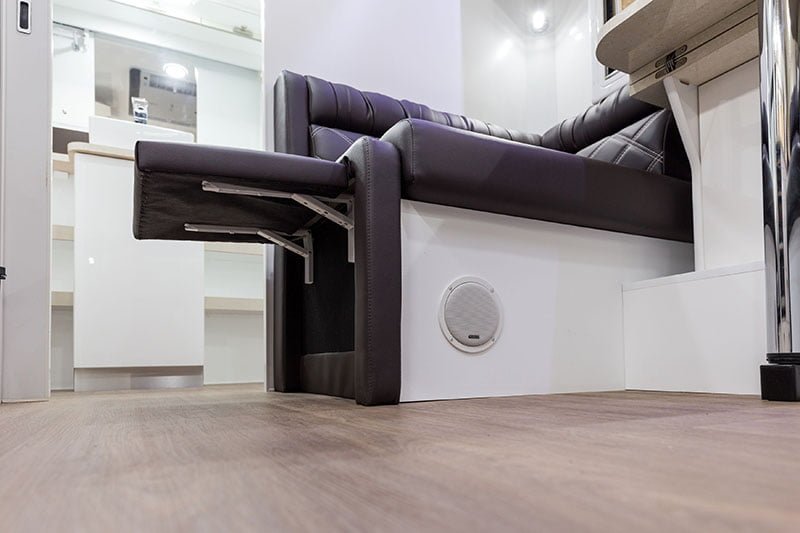 The kitchen has a good amount of storage on offer and decent appliances, including a 181L Thetford three-way fridge/freezer. The cabinetry, from the glossy finish to the joinery, is as neat as a pin. The same goes for the dinette, which is upholstered in Annahide. I liked the snap-up footrests and the fact that the speakers are mounted in the space beneath the lounges. To be honest, I found accessing the storage space here somewhat difficult, but the packing space here is rather limited in any case, considering it’s the location of the onboard battery, charger, 12V fuses and the controller for the 150W roof-mounted solar panel.
The kitchen has a good amount of storage on offer and decent appliances, including a 181L Thetford three-way fridge/freezer. The cabinetry, from the glossy finish to the joinery, is as neat as a pin. The same goes for the dinette, which is upholstered in Annahide. I liked the snap-up footrests and the fact that the speakers are mounted in the space beneath the lounges. To be honest, I found accessing the storage space here somewhat difficult, but the packing space here is rather limited in any case, considering it’s the location of the onboard battery, charger, 12V fuses and the controller for the 150W roof-mounted solar panel.
Because of the minimal amount of space at the foot of the bed, Roadstar has kept the floor at the entrance flat – the cut-out step familiar to many vanners is absent. Underneath the queen-size bed, the storage area is somewhat occupied by the tunnel storage space as well as the offside Swift water heater (which also takes up some of the offside wardrobe space). I couldn’t help but like the bedside storage nooks, though, each with their own internal light.
Along with features such as a flatscreen TV, reverse-cycle air-conditioner, soft-glow LED lights that lend the van a rather classy ambience, the Little Rippa has a first-rate finish.
GORV’S VERDICT
The Little Rippa in fibreglass form is an interesting package. Yes, it can come with a timber or aluminium frame, and composite aluminium cladding, if you prefer this type of material.
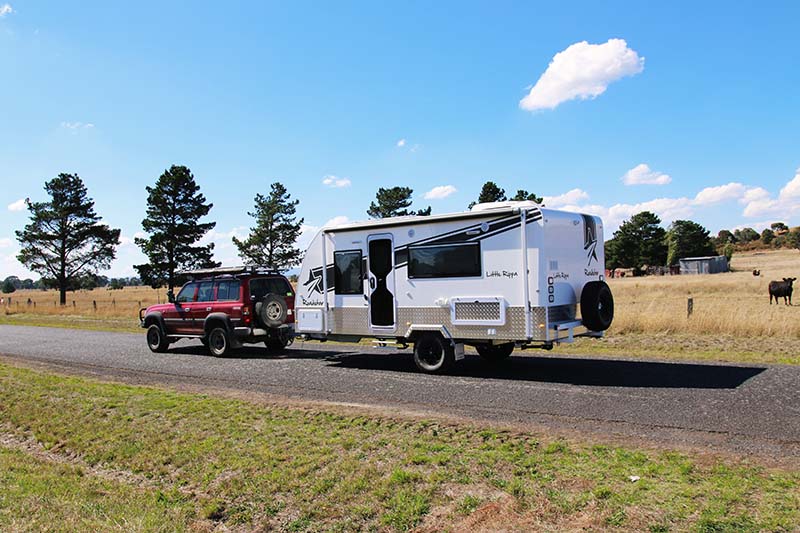 Overall, this caravan has serious long-term touring potential at a size and weight that’s comfortable for many mid-range 4WDs. There is nothing slap-dash about this rig, either. The fit and finish is up there with the best of them.
Overall, this caravan has serious long-term touring potential at a size and weight that’s comfortable for many mid-range 4WDs. There is nothing slap-dash about this rig, either. The fit and finish is up there with the best of them.
THE SCORE
FIT AND FINISH – 
LAYOUT – 
INNOVATION – 
HITS & MISSES
COMPLETE SPECS
Overall length: 7.6m
External cabin length: 5.5m
External cabin width: 2.4m (excluding awning)
Travel height: 3.1m
Internal height: 1.94m
Tare: 2020kg
GTM: 2340kg
ATM: 2520kg
Unladen ball weight: 180kg
Frame: N/A
Panelling: Fibreglass sandwich panel with one-piece fibreglass front, roof and rear section
Coupling: Ball
Chassis 6in SupaGal
Suspension: Al-Ko Enduro Outback
Brakes: Electric
Wheels: 16in alloy
Fresh water: 2x95L
Awning: Dometic roll-out
Battery: 120Ah AGM
Solar: 150W
Air-conditioner: Truma Aventa
Gas cylinders: 2x9kg
Sway control: no
Cooking: Swift four-burner with griller
Refrigeration: Thetford 181L three-way fridge/freezer
Microwave: Yes
Toilet: Thetford cassette
Shower: Separate cubicle
Washing machine: Wall-mounted front-loader
Lighting: 12V LED
Hot water: 28L Swift gas/electric
$86,990 (RRP)


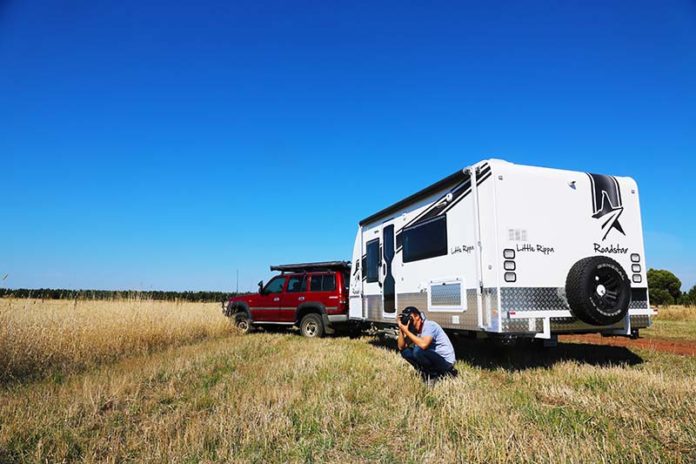
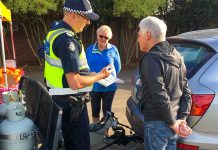



The Little Rippa in full off road mode ticks a lot of boxes and is definitely worth considering as a touring van. I do have lots of questions, like can this van be customised to suit our needs. There are a few things missing, like Dexter sway control, lithium battery/inverter setup attached to a decent amount of solar panels. Can we change the ensuite to a combo shower toilet cubicle with an Enviropro composting toilet plus a 12V compressor fridge possibly the Vitrigio below bench 2 drawer fridge/Freezer. This is how our last van was setup and it was great. Pity that caravan manufacturer didn’t know quiet what they were doing as they had only been building Caravans for 3 years.
Hi Phillip, I suspect that many of the things you have listed can be added by Roadstar but I’m not sure about the bathroom switch – best to chat to them about that.